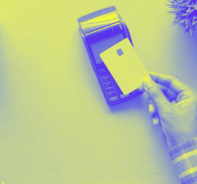Learn how secure online payment processing protects your customers and business from risk and fraud.
Fraudsters are on the lookout for vulnerabilities they can use to access systems and steal data. Yet shoppers still need to be able to complete transactions using their preferred payment method and enjoy an efficient and frictionless experience when they pay.
To protect their customers and their businesses while still delivering a great checkout experience, merchants need to understand the best security practices online when accepting credit card payments and alternative payment methods.
10 Best Practices for Secure Online Payment Processing
Table of Contents
- 10 Best Practices for Secure Online Payment Processing
- Match the IP and Billing Address Information
- Encrypt Data
- Use Payment Tokenization
- Require Strong Passwords
- Implement 3D Secure
- Request the CVV
- Use Strong Customer Authentication (SCA)
- Monitor Fraud Continuously
- Manage PCI Compliance
- Train Employees
- Download the Guide: How to Reduce Your Payment Risks for Cross-Border eCommerce
- Rapyd Offers Built-In Payment Fraud Protection with Advanced Features
The Three Pillars of Secure Online Payment Processing
There are three factors that merchants need to understand and manage to create a checkout experience that is simple, secure and provides protection for all payment methods – including credit and debit cards and alternative payment methods.
Three Factors to Reduce Payment Risk
- Fraud
- Security
- Compliance
Fraud
Fraud management is key to businesses and can require changes to the payment methods offered and additional buyer identification verification. High rates of fraud can result in credit card companies revoking a merchant’s right to process payments and also negatively impact the reputation of the business.
Security
As cybercriminals seek out vulnerabilities to give them an opportunity to steal valuable personal and financial data, merchants need to ensure that the payment process is secure and protects valuable business and customer data.
Compliance
Privacy and data security standards set by regulatory bodies or by individual countries are designed to protect businesses and individuals. Merchants need to understand what their obligations are and ensure they continue to comply with requirements everywhere they do business.
10 Best Practices for Secure Online Payment Processing
Match the IP and Billing Address Information
Checking details provided during the transaction can help flag a potentially fraudulent transaction and protect the business before fraud occurs. Address Verification Service (AVS) compares the IP address of the buyer to the billing address of the credit card used to provide assurance that the customer is the cardholder.
Encrypt Data
SSL and TLS – (Transport Layer Security) TLS and (Secure Sockets Layer) are protocols that authenticate and encrypt data when moving on the Internet. Securing transactions with SSL protocols ensure that sensitive information is encrypted and only accessible by the intended recipient.
Use Payment Tokenization
Credit card tokenization de-identifies sensitive payment information by converting it to a string of randomly generated numbers, called a “token.” As a token, the information can be sent through the internet or payment networks to complete payment without being exposed.
Require Strong Passwords
Cybercriminals try to access user accounts with frequently used combinations of names, birthdays and dictionary words. Protecting customer accounts with a strong password can add a line of defense. In the event that the customer can not remember their strong password, there does need to be a “forgot your password” process in place to allow them to access their account.
Implement 3D Secure
3D Secure is a method of authentication designed to prevent the unauthorized use of cards and protects ecommerce merchants from chargebacks in the event of a fraudulent transaction. Merchants, card networks and financial institutions share information to authenticate transactions. All merchants are required to comply with new EU laws for strong customer authentication and 3D Secure is an efficient way to do this.
Request the CVV
The Card Verification Value (CVV) can be used to validate card-not-present transactions either on the phone or online. If the credit card numbers have been stolen, asking for information that is only available on the card can help merchants validate the payment.
Use Strong Customer Authentication (SCA)
SCA is used to reduce fraud and increase online payments security and asks for two or more elements from the use in the authentication process. Something you know (a password or PIN), something you have (a badge or smartphone) or something you are (fingerprints or voice recognition).
Monitor Fraud Continuously
Merchants need a payment gateway that detects and manages fraud. Built-in fraud monitoring identifies where there may be a real risk of a fraudulent purchase. Businesses can set rules, based on their situation and tolerance for risk, that limit or reject transactions that are deemed too high-risk, or require manual approval before a transaction is completed.
Manage PCI Compliance
Merchants that process, store or transmit credit card data are required to be PCI compliant. The consequences of a data breach for a non-compliant business are significant and can include costly fines and penalties in addition to significant reputational damage.
Payment processors play an important role in helping merchants to manage and maintain compliance, but businesses should take a proactive role to understand their obligations and compliance requirements.
Train Employees
Provide individuals with the knowledge and skills that enable them to recognize and respond appropriately. When the team understands the secure payment process they are better prepared to identify the fraudulent activity as it is happening and can prevent information security incidents.
Employing these best practices for secure online payment processing is an important component for international ecommerce success.
Download the Guide: How to Reduce Your Payment Risks for Cross-Border eCommerce
Rapyd Offers Built-In Payment Fraud Protection with Advanced Features
Using the multifaceted fraud protection available through Rapyd Collect that comes complete with Rapyd Protect, you can have greater safety from the risk of fraud, no matter where you do business or what payment methods you accept. Rapyd Collect also lets you accept alternative payments methods that have very little chargeback risk such as bank transfers, cash vouchers and more.
- Fraud coverage in 100+ countries
- Fraud protection for hundreds of payment methods
- Covering 2 million global access points
Subscribe Via Email
Thank You!
You’ve Been Subscribed.



